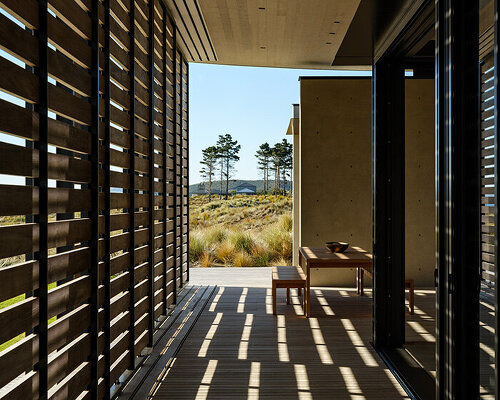a home emerges from the dunes
Te Whare Tupu Kirikiri, a coastal residence by Olson Kundig, has been completed on New Zealand’s North Island. Sited among the dunes and Pohutukawa trees of Mangawhai, the project reinterprets the modest architectural language of the bach, a style of beach house typical to the area.
Approached by a winding drive through shifting sands and native vegetation, the house gradually appears as a quiet extension of its landscape. Its low-slung form and concrete exterior echo the grain and tone of the surrounding terrain. A curving roof anchors the composition, casting controlled light and sheltering the structure from the high-exposure coastal environment.
‘One of my favorite parts of this project is the roof design,’ says Tom Kundig, FAIA, RIBA, Design Principal. ‘We developed what we called ‘the surfboard’ — a roof structure that curves both above and below. This unique shape not only channels water efficiently but also shapes how light enters the space below.’
images © Simon Devitt
olson kundig’s composition of shelter and exposure
The architects at Olson Kundig hide Te Whare Tupu Kirikiri among New Zealand’s coastal landscape so that it might unfold gradually upon approach. A steel gate leads to a central courtyard framed by three earthen wings and a floating roof plane, which blurs at its edges into the sky. The surface of the roof reflects light from the adjacent pool and ocean beyond, softening the threshold between structure and landscape. Guillotine glazing and sliding walls connect the courtyard to the open-plan living areas and exterior deck, creating continuity between interior and exterior zones.
‘One of the most compelling parts of this home is how the experience unfolds through the courtyard,’ Kundig elaborates. ‘As you enter, the architecture opens up, guiding you through the courtyard to the shoreline. The structure seems to dissolve into the horizon, blurring the line between interior and exterior.’
The architect continues: ‘New Zealand has such a high-exposure, coastal environment. We created a refined shutter system that transforms the space with a simple gesture and responds dynamically to that environment. It opens and closes to protect the interior from harsh winds while allowing it to fully open to the shoreline in calm conditions.’
Te Whare Tupu Kirikiri is a coastal home designed by Olson Kundig on New Zealand’s North Island
Material Palette and Landscape Integration
Inside the New Zealand beach house, Olson Kundig introduces a restrained material palette of concrete, teak, and stone, bringing together regional textures with careful detailing. Teak-paneled ceilings and custom cabinetry carry a weathered quality, resembling sun-bleached driftwood. Bedrooms are oriented for privacy and views, each with a path leading directly to the nearby wetlands and beach.
‘Architecture is experiential — it’s something that must be felt physically, not just seen,’ says Kundig. ‘As you move through Te Whare Tupu Kirikiri, it seems to float and open up, creating a connection to the landscape. The way the architecture engages with both the protected courtyard and the distant horizon is something you have to experience to fully understand.’
a curving concrete roof with softened edges reflects light and channels water
the structure is embedded in dunes and framed by native Pohutukawa trees
a steel gate leads to a central courtyard framed by glass walls and earthen wings
operable shutters and sliding walls allow the house to adapt to shifting coastal conditions
a restrained palette of concrete teak and stone brings regional textures into the minimalist interior
bedrooms open to direct paths through native wetlands
project info:
name: Te Whare Tupu Kirikiri
architect: Olson Kundig | @olsonkundig
location: North Island, New Zealand
area: 6,685 square feet
completion: 2023
photography: © Simon Devitt | @simondevitt_photographer
project team: Tom Kundig, FAIA, RIBA, Design Principal; Edward Lalonde, Principal; Simon Clews, Project Manager/Project Architect; Michael Cady, AIA, Project Architect; Hilary Schanck, AIA, LEED, AP, B+C, Connor Irick, Architectural Staff
key consultants:
contractor: Lindesay Construction
local architect: Studio John Irving Architects
interior design: Kerry Joyce Associates
interior design support: Studio Ost
building performance: Oculus
client rep: Carnoustie Management LTD.
local client rep: Karae Ltd
kinetics: KB Architectural
structural engineers: Structural Design Solutions Ltd
landscape architect: 02 Landscapes
civil engineer: Earthtech
mechanical engineer: Celsius Consulting Ltd
electrical engineer: Level Electrical Morningside
lighting design: Niteo
The post olson kundig frames new zealand coastline with modern beach house ‘te whare tupu kirikiri’ appeared first on designboom | architecture & design magazine.

